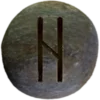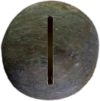Last Updated on June 17, 2025
Table of Contents


The Body of the Cosmos
Ymir (pronounced EE-mir) is a primeval being in Norse mythology. He appears as the first jötunn (giant) and plays a key role in the creation of the cosmos. His name is often spelled Ýmir. ![]()
Ymir formed from the melting ice of Niflheim and the heat of Múspellsheimr. This meeting of fire and ice occurs in the primordial void, Ginnungagap. As the rime melts and drips, He comes into being. Ymir is not born in the usual sense. He simply emerges from the chaos and frost, fully formed and alive.
Ymir is not alone for long. As he sleeps, he sweats. From his left armpit grow a man and a woman. From his legs, a six-headed son forms. These beings become the ancestors of the frost giants. Thus, he serves as the progenitor of an entire race. His body produces life without intention or effort.
Alongside Ymir comes Auðhumla (pronounced OATH-oom-blah), a cosmic cow. She also forms from the melting ice. She sustains him by feeding him her milk. While licking salty ice blocks, Auðhumla uncovers another being: Búri (pronounced BOO-ree), the first of the gods. Búri later fathers Borr, who in turn fathers Odin, Vili, and Vé.
These three gods—Odin, Vili, and Vé—eventually kill Ymir. His death is not just an act of violence but a creative moment. Ymir’s body becomes the foundation of the world. His flesh forms the earth. His blood becomes the oceans and rivers. His bones turn into mountains, his teeth into rocks. The gods use his skull as the sky and place it over the world.
His Death and the Shaping of the Cosmos
Ymir’s blood floods the world, and drowns nearly all the frost giants, except for one: Bergelmir (pronounced BEHR-gel-meer) and his wife. They escape the flood on a lur or hollowed-out tree. From them, the race of jötnar continues. This event echoes flood myths in other cultures.
The gods place his brain in the sky where it becomes the clouds. His eyebrows form Midgard, the realm of humans. In this myth, death gives way to structure. Chaos yields to order. The gods impose boundaries on the world using his remains.
He appears in the Völuspá and the Gylfaginning, two major sources in the Poetic Edda and Prose Edda. The Völuspá, a poem spoken by a seeress, briefly describes his origin and death. The Gylfaginning, written by Snorri Sturluson, gives more detail. It explains how the gods shape the world from Ymir’s body and arrange the cosmos.
He plays no active role beyond his existence and death. He does not speak or act. Instead, he serves as raw material. His presence is necessary but passive. The gods act upon him. His body, not his will, shapes reality.
While his name may suggest a connection to the Old Norse verb yma, meaning “to roar,” this remains uncertain. Scholars debate the name’s exact meaning. Some think it ties to sound or confusion, reflecting the chaotic state before creation.
The myth of Ymir offers a rare look at a creation story without benevolent intention. The gods do not mold clay or speak life into being. They dismember a primordial being and fashion the world from his corpse. This brutal process highlights a theme in Norse myth: creation often follows destruction.
Runes Associated with Ymir
The runes Isaz (ᛁ) and Hagalaz (ᚺ) symbolize aspects of his nature and story. Isaz (EE-sahz) represents ice, embodying the frozen void of Niflheim that birthed Ymir. It reflects stasis and raw potential. Hagalaz (HAH-gah-lahz) signifies hail, a force of chaos and change, resonating with his destructive and creative role. Together, these Elder Futhark runes capture Ymir’s duality of primal chaos and life-giving energy. ![]()
His Importance to Asatru
To Asatruar, Ymir represents the primal forces that shaped the world and humanity’s place within it. His story reminds followers of life’s cyclical nature and humanity’s connection to the cosmos. Ymir’s transformation into the physical world reflects themes of sacrifice and renewal. These lessons inspire Asatruar to honor the balance of creation and destruction in their spiritual practices.

